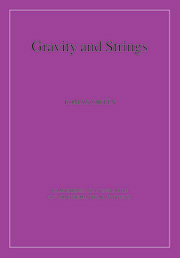Book contents
- Frontmatter
- Contents
- Preface
- Part I Introduction to gravity and supergravity
- 1 Differential geometry
- 2 Noether's theorems
- 3 A perturbative introduction to general relativity
- 4 Action principles for gravity
- 5 N = 1, 2, d = 4 supergravities
- 6 Conserved charges in general relativity
- Part II Gravitating point-particles
- Part III Gravitating extended objects of string theory
- Appendix A Lie groups, symmetric spaces, and Yang–Mills fields
- Appendix B Gamma matrices and spinors
- Appendix C n-Spheres
- Appendix D Palatini's identity
- Appendix E Conformal rescalings
- Appendix F Connections and curvature components
- Appendix G The harmonic operator on ℝ3 × S1
- References
- Index
5 - N = 1, 2, d = 4 supergravities
Published online by Cambridge University Press: 20 February 2010
- Frontmatter
- Contents
- Preface
- Part I Introduction to gravity and supergravity
- 1 Differential geometry
- 2 Noether's theorems
- 3 A perturbative introduction to general relativity
- 4 Action principles for gravity
- 5 N = 1, 2, d = 4 supergravities
- 6 Conserved charges in general relativity
- Part II Gravitating point-particles
- Part III Gravitating extended objects of string theory
- Appendix A Lie groups, symmetric spaces, and Yang–Mills fields
- Appendix B Gamma matrices and spinors
- Appendix C n-Spheres
- Appendix D Palatini's identity
- Appendix E Conformal rescalings
- Appendix F Connections and curvature components
- Appendix G The harmonic operator on ℝ3 × S1
- References
- Index
Summary
In the previous chapter, we introduced increasingly complex theories of gravity, starting from GR, to accommodate fermions and we saw that the generalizations of GR that we had to use could be thought of as gauge theories of the symmetries of flat spacetime.
A very important development of the last few decades has been the discovery of supersymmetry and its application to the theory of fundamental particles and interactions. This symmetry relating bosons and fermions can be understood as the generalization of the Poincaré or AdS groups which are the symmetries of our background spacetime to the super-Poincaré or super-AdS (super-)groups which are the symmetries of our background superspacetime, a generalization of standard spacetime that has fermionic coordinates.
It is natural to construct generalizations of the standard gravity theories that can be understood as gauge theories of the (super-)symmetries of the background (vacuum) superspacetime. These generalizations are the supergravity (SUGRA) theories. Given that the kind of fermions that one can have depends critically on the spacetime dimension, the SUGRA theories that one can construct also depend critically on the spacetime dimension. Furthermore, one can extend the standard bosonic spacetime in different ways by including more than one (N) set of fermionic coordinates. This gives rise to additional supersymmetries relating them and, therefore, to supersymmetric field theories and SUGRA theories with N supersymmetries. The latter are also known as extended SUGRAs (SUEGRAs).
- Type
- Chapter
- Information
- Gravity and Strings , pp. 150 - 170Publisher: Cambridge University PressPrint publication year: 2004

